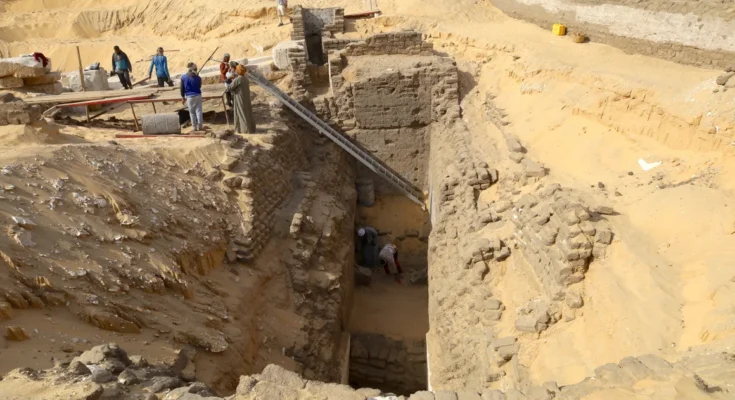An ancient Egyptian tomb recently uncovered in Abydos is offering new insights into a royal figure who ruled over 3,600 years ago.
Archaeologists unearthed the grand limestone burial site in January, revealing multiple chambers and an elaborately decorated entrance. However, the identity of the tomb’s intended occupant remains unknown. According to a March 27 announcement from the Penn Museum at the University of Pennsylvania, looters damaged the hieroglyphic inscriptions on bricks near the entrance, erasing the name.
No skeletal remains were found inside the tomb to help identify who was buried there. Still, researchers believe it likely belonged to a king who ruled Upper Egypt during the Second Intermediate Period (circa 1640–1540 BC), possibly linked to the obscure Abydos Dynasty. This mysterious ruler may be among those missing from official royal records, which leaves many aspects of the era shrouded in uncertainty.

“It’s a very mysterious and enigmatic dynasty—one that seems to have been largely forgotten in Egypt’s ancient records, likely due to the political instability and fragmentation of the time,” said Josef Wegner, an Egyptologist and professor of Egyptian archaeology at the University of Pennsylvania, who led the excavation. “This discovery opens an entirely new path for exploring the Abydos Dynasty.”
The tomb is the largest burial chamber ever found from any known ruler of that elusive dynasty, shedding new light on a little-understood chapter of Egyptian history—one that can only be pieced together through surviving physical evidence, according to experts.
The Lost Pharaoh
Archaeologists uncovered the tomb nearly 23 feet (around 7 meters) beneath the surface at an ancient necropolis known as the “city of the dead.” Located at Anubis Mountain in Abydos—a naturally pyramid-shaped formation revered by the ancient Egyptians—the site was considered sacred and helped conceal the tombs hidden below.
Historically, Abydos was regarded as a sacred city, believed to be the final resting place of Osiris, the god of the underworld, and a favored burial site for Egypt’s earliest pharaohs. Over the centuries, the necropolis expanded as successive dynasties built tombs for their rulers within this royal cemetery.
More than a decade ago, Wegner and his team uncovered the first tomb in this necropolis that provided concrete evidence of the Abydos Dynasty, a royal lineage first proposed in 1997 by Egyptologist Kim Ryholt. Ryholt suggested that this smaller dynasty likely ruled the Abydos region during a period when ancient Egypt was divided into competing kingdoms.
The first tomb discovered belonged to King Seneb-Kay, a previously unknown pharaoh not mentioned in any historical records. Of the eight tombs from the Abydos Dynasty uncovered so far, Seneb-Kay’s is the only one with an intact name inscribed within the burial chamber.
The newly discovered tomb shares architectural and decorative similarities with Seneb-Kay’s, but it is significantly larger. The main compartment of this three-chambered crypt measures about 1.9 meters (6.2 feet) in width and 6 meters (19.7 feet) in length. Since the tomb is located in an earlier-established section of the necropolis, researchers believe the wealthy king buried there may have been a predecessor to Seneb-Kay.
Scientists speculate that the tomb could belong to King Senaiib or King Paentjeni, two monarchs who appear in the limited archaeological record of the Abydos Dynasty, represented in a monument at Abydos. However, Wegner, who is also the curator of the Penn Museum’s Egyptian section, notes, “It is equally possible there could be some entirely unknown king. We don’t think we have all of (the Abydos kings’) names — evidence hasn’t survived consistently for them.”
Though there are no markings to identify the tomb’s occupant, two painted images of the goddesses Isis and Nephthys remain. These goddesses were commonly depicted in funerary rites, often shown mourning the deceased.
The team plans to survey an additional 10,000 square meters (over 100,000 square feet) of desert land to uncover more tombs. Wegner estimates, “There could easily be 12 or 15 kings that compose this group of kings.”
In addition to continuing their excavation, the researchers will use ground-penetrating radar to scan the area. This technology utilizes sound waves to map structures beneath the Earth’s surface, while magnetometry will help create maps of underground structures with magnetic signatures.
“The discovery of another ruler from the Abydos dynasty is incredibly exciting,” said Salima Ikram, a distinguished professor of Egyptology at the American University in Cairo, in an email. “It confirms that there was a significant royal cemetery from that era, provides further insight into royal tomb architecture, and offers clues about the members of this dynasty and the sequence of their rule.”
Although Ikram was not part of the excavation, she expressed optimism that future digs will uncover more tombs, helping to “deepen our understanding of this once-obscure period of Egyptian history.”
Rewriting Ancient Egyptian History
Kings from the Abydos Dynasty, such as Seneb-Kay, are particularly significant because they are absent from the official king lists once maintained by the ancient Egyptians.
“The Egyptian kings preferred to present their history as a straightforward, linear narrative, recording the names of rulers in order. These kings don’t appear on those lists, so when we refer to the strict historical record, there’s no room for them,” explained Laurel Bestock, an Egyptologist and associate professor of archaeology at Brown University. Bestock, who was not involved in the recent discovery, emphasized the importance of these findings in rewriting parts of Egypt’s royal history.
“When we uncover these monuments, it highlights how flawed the traditional, linear historical record really is,” Bestock explained. “It wasn’t created to be accurate; rather, it was written to support a particular narrative favored by later kings who reunited Egypt. These kings portrayed themselves as great conquerors, victorious in ethnic wars, while ignoring all the smaller players.”
Findings like the new Abydos tomb are “incredibly exciting,” Bestock added, because they offer a more nuanced view of history, regardless of whether the identity of the king is ever revealed.
At present, the identity of the ruler buried in the tomb remains unknown, but Wegner is determined to one day pinpoint the king’s name to better place him within Egypt’s historical timeline. “With archaeology, you hope for evidence,” Wegner said. “The archaeological record always surprises you, with twists and turns along the way—so you never really know what you might uncover.”



